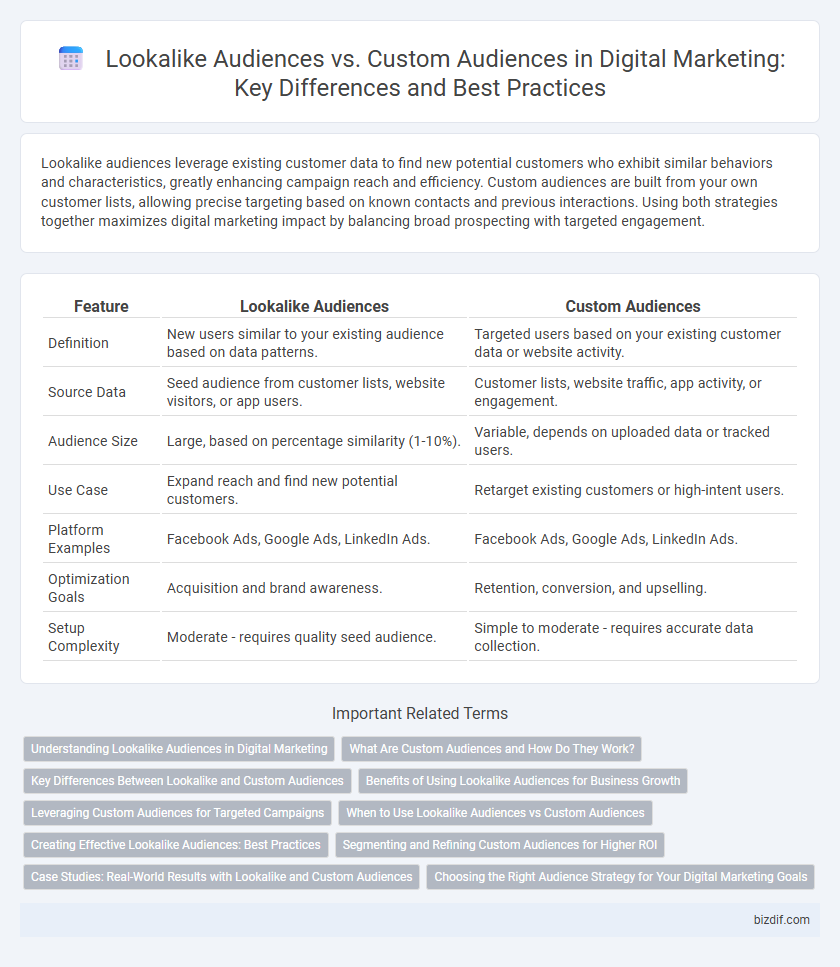Lookalike audiences leverage existing customer data to find new potential customers who exhibit similar behaviors and characteristics, greatly enhancing campaign reach and efficiency. Custom audiences are built from your own customer lists, allowing precise targeting based on known contacts and previous interactions. Using both strategies together maximizes digital marketing impact by balancing broad prospecting with targeted engagement.
Table of Comparison
| Feature | Lookalike Audiences | Custom Audiences |
|---|---|---|
| Definition | New users similar to your existing audience based on data patterns. | Targeted users based on your existing customer data or website activity. |
| Source Data | Seed audience from customer lists, website visitors, or app users. | Customer lists, website traffic, app activity, or engagement. |
| Audience Size | Large, based on percentage similarity (1-10%). | Variable, depends on uploaded data or tracked users. |
| Use Case | Expand reach and find new potential customers. | Retarget existing customers or high-intent users. |
| Platform Examples | Facebook Ads, Google Ads, LinkedIn Ads. | Facebook Ads, Google Ads, LinkedIn Ads. |
| Optimization Goals | Acquisition and brand awareness. | Retention, conversion, and upselling. |
| Setup Complexity | Moderate - requires quality seed audience. | Simple to moderate - requires accurate data collection. |
Understanding Lookalike Audiences in Digital Marketing
Lookalike audiences in digital marketing target new users who share similar characteristics with existing customers, enhancing campaign reach and effectiveness. By leveraging data from custom audiences, platforms like Facebook create these profiles to find prospects likely to engage or convert. This strategy optimizes ad spend by focusing on potential customers with higher relevance and conversion potential compared to broad targeting methods.
What Are Custom Audiences and How Do They Work?
Custom audiences are groups of users compiled from existing customer data such as email lists, website visitors, or app users to target highly relevant and personalized ads. These audiences leverage first-party data to deliver precise ad campaigns by matching user identities across platforms, enhancing engagement and conversion rates. By focusing on users already familiar with the brand, custom audiences improve ad efficiency and optimize marketing spend.
Key Differences Between Lookalike and Custom Audiences
Lookalike audiences target new users who share similar behaviors and characteristics with your existing customers, enhancing audience reach for acquisition campaigns. Custom audiences use data from your existing contacts, website visitors, or app users to retarget or engage individuals already familiar with your brand. Key differences include the source of the audience, with Custom relying on first-party data and Lookalike leveraging Facebook's algorithm to find new but similar users.
Benefits of Using Lookalike Audiences for Business Growth
Lookalike audiences enable businesses to reach new potential customers who share similar characteristics with their best existing clients, increasing the likelihood of conversion. By leveraging data from custom audiences, marketers can expand their reach efficiently while maintaining targeting precision, resulting in higher return on ad spend (ROAS). This audience targeting strategy accelerates business growth by optimizing ad performance and reducing customer acquisition costs.
Leveraging Custom Audiences for Targeted Campaigns
Leveraging Custom Audiences in digital marketing allows businesses to target specific segments based on existing customer data, resulting in higher engagement and conversion rates. Custom Audiences use email lists, website visitors, or app users to create precise, personalized campaigns tailored to users' behaviors and interests. This targeted approach maximizes ROI by focusing ad spend on users already familiar with the brand, enhancing relevance and response rates.
When to Use Lookalike Audiences vs Custom Audiences
Lookalike audiences excel when expanding reach to new potential customers who share similar behaviors and interests with your best existing clients, making them ideal for scaling campaigns. Custom audiences are best used for targeting specific groups, such as past website visitors, existing customers, or email subscribers, to drive conversions and re-engage users. Choosing between lookalike and custom audiences depends on campaign goals: acquisition benefits from lookalikes, while retention and remarketing rely on custom audiences.
Creating Effective Lookalike Audiences: Best Practices
Creating effective Lookalike Audiences requires leveraging high-quality Custom Audiences as seed data, ensuring the source audience is both relevant and sizable, typically between 1,000 to 50,000 individuals. Segmenting Custom Audiences by specific behaviors, demographics, or engagement levels enhances the precision of Lookalike models, driving higher conversion rates. Continuously refining and testing different audience sizes and characteristics helps optimize targeting efficiency and maximize return on ad spend (ROAS).
Segmenting and Refining Custom Audiences for Higher ROI
Segmenting and refining custom audiences enable precise targeting by leveraging existing customer data such as purchase history, engagement levels, and demographics to create highly relevant segments. Compared to lookalike audiences, custom audiences allow marketers to focus on high-value customers with tailored messaging, increasing conversion rates and maximizing return on investment (ROI). Utilizing layered segmentation strategies within custom audiences improves ad personalization and reduces ad spend wastage, driving more efficient digital marketing campaigns.
Case Studies: Real-World Results with Lookalike and Custom Audiences
Case studies reveal that businesses using lookalike audiences often experience a 30% increase in conversion rates by targeting users similar to their highest-value customers, while custom audiences drive stronger engagement with existing followers through personalized campaigns. E-commerce brands reported a 25% decrease in cost per acquisition when leveraging custom audiences combined with lookalike expansion strategies, maximizing ad spend efficiency. Real-world results emphasize the synergy of both approaches in optimizing reach and boosting ROI across platforms like Facebook and Instagram.
Choosing the Right Audience Strategy for Your Digital Marketing Goals
Choosing the right audience strategy in digital marketing hinges on your campaign objectives: Lookalike audiences help expand reach by targeting users similar to your existing customers, ideal for brand awareness and acquisition. Custom audiences enable precise retargeting based on existing customer data, driving higher conversion rates through personalization. Aligning your strategy with these differences optimizes ad spend and maximizes return on investment.
Lookalike audiences vs Custom audiences Infographic

 bizdif.com
bizdif.com